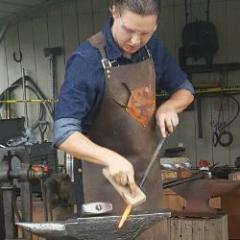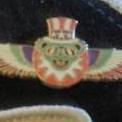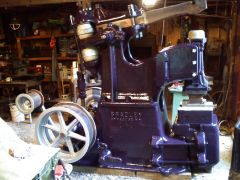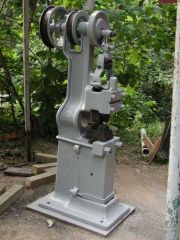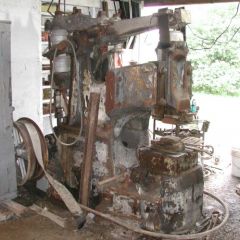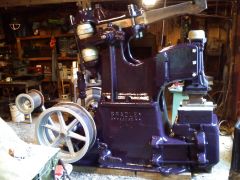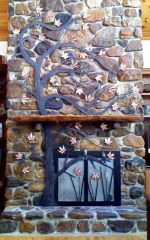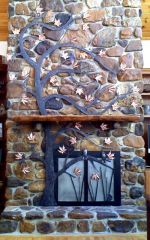
frogvalley
Members-
Posts
201 -
Joined
-
Last visited
Contact Methods
-
Website URL
http://www.frogvalleyforge.com
Profile Information
-
Gender
Male
-
Location
Berkeley Springs, WV
-
Interests
Blacksmithing, metal sculpture, kayaking, sailing, photgraphy
Converted
-
Location
Berkeley Springs ,WV
-
Biography
I come from a long line of blachsmiths dating back to the 1700's.
-
Interests
Art, blacksmithing, biking
-
Occupation
Artist Blacksmith- Full Time
Recent Profile Visitors
3,262 profile views
-
-
We went with purple as a final color, with silver trim and drive components. Purple power hammer sounds a bit rude, but there you have it. After a three year project, buying, moving it 300 miles, building an addition to house it, digging a five foot deep foundation, moving the machine inside, cleaning and repainting and this week setting her on her new concrete its been a very long road. Attached is a before and after pic. Soon...
-
-
-
Vibration isolation in Power Hammer
frogvalley replied to rambo's topic in Power Hammers, Treadle Hammers, Olivers
The question I have is not how to dampen the vibration, but why? It seems you have plenty of isolation already. The effort and expense involved in MORE isolation may not be worth it. There is going to be an acceptable level, an almost unavoidable level of transfer of vibration with such a big hammer. All of the large industrial hammers I know of shake the ground a bit. Is the vibration causing problems? Would it be easier to isolate the other equipment around the hammer to prevent the vibes from effecting them? -
cant figure this out - hardy holes are not square
frogvalley replied to burnsy the smithy's topic in Problem Solving
Its my 2 cents that someone simply enlarged the pritchell hole on a soft faced anvil. Yup, pass on this one. -
The action of both types of helve hammers, those with full length spring helves and those with supposed solid beams and one end spring or cushion, is virtually identical. Where you put the spring(s) , whether it be one or both ends, makes little difference. The design of the controls and adjustments for the hammer make the primary difference in tunabilty. Ask anyone who has used both a Dupont/Fairbanks hammer with its stroke and height adjustments and a Little Giant without brakes or decent adjustments. Once again, it is my opinion that the reason that we tend to build these using leaf springs is expediency and ease of construction, and the tendency towards lighter frames, hence requiring a more flexible coupling in order to reduce vibration through the frame.
-
I've used hundreds of linear feet of them, they are free in the trash in most cities, plus they get dropped off here by everybody. Oh you're a blacksmith, you can use these. They are hard, but WILL cut fine on a bandsaw if you have a good blade and the right feed. I've never had trouble cutting them. I weld them mostly, but have drilled them, I use Cobalt drills without incident, although they will drill with reg HS drills, it is crunchy. Stock racks, shelf brackets any 1/8 angle projects around the shop. Free is the price, and easy to deal with.
-
A solid arm? Wood is quite flexible and most helve hammers have wooden helves. Granted it is not as flexible as a spring, but it is not iron. A more appropriate comparison of hammer styles is not with the unguided helve hammers, but with a guided helve such as the Bradley's. There are flexible coupling at both ends of the helve, a large series of rubber cushion on one end and a rubber or leather connector at the ram end. I own a 75# Appalachian style and a 300# Bradley guided helve. It is my opinion that the reason for the difference in flexible materials is simply that in order to fully transmit the force from the motor to the ram, a super heavy frame is required, the less flexible the helve, the stronger the frame/body needs to be. Otherwise they would just beat themselves to death and vibrate uncontrollably. One other reason is that in order to make a wider range in your workable heights for the appalachian hammers it is necessary to allow more flex in the helve. Differing work heights and actual stroke length are fully adjustable on a more sophisticated machine such as the Bradley(stiffer helve). My appalachian has one adjustment, a sleeve adjustable crank, but no allowance for stroke adjustment(very flexible spring helve). If anyone has any other information regarding this, please chime in.
-
Two points to consider. One is that alot depends on the actual shape of the edge of your anvil. If its really rounded over like my Peter Wright, its less efficient to fuller over the edge. If your edge is sharper, it'll move more metal. You can't judge this process without setting some parameters for a test. Other wise we're mostly talking anecdotal evidence. Two is that energy is lost during the movement of a hammer at the moment it strikes a piece of work at anything other than perfectly parallel and/or centered strikes. If you balance your hammer pretty well its helps, but since it swings in an arc (assuming over the edge with a little reach) and the stock changes thickness during the hit it is all but impossible to make it hit perfectly parallel, hence some loss through the handle. Even using different hammer methods, ie, Hofi or your own personal style. I prefer to use the edge of the anvil hit straight on for fullering larger stock. That is if its my Fisher with the sharp edge, not on the Peter Wright. Smaller stock I start over the edge and then finish with more control but less efficiency on the face with an angle blow and then finish blows angled another way to make it smooth. Some shapes of stock of course require the horn to fuller them. So much of this comes down to the requirements of the workpiece.
-
Do you want a shaft with the splines outside (male) or a square block 6" long with a 5/8 splined hole inside (female)? I would not try to put accurate splines on a long internal hole, thats more of a job for a shaper that can index and bore out the grooves. External splines are more often rough forged and at least finished by milling , if not cut from the raw stock entirely with a mill. You almost need a milling machine to make a die to form the splines to make a rough forging that you might need to mill for accuracy. Chicken and egg.
-
I agree with Frosty , I'd do a test in a weak acid, acetic acid 5% would be my choice. Of course I have a 35 gallon tank of it so easier done than said. A vibratory cleaner, with some fine abrasive or shot media might work, you could rig something up with a five gallon bucket or a similar soft container with fine media. Oh and sometimes, just sometimes, using a very hot torch just playing over the surface of a piece of iron can heat and pop the scale off. Just be sure to heat very quickly and not too long. I like the idea of a wax resist, though the strength of the muriatic might be a bit much, but I am timid with acid and copper.


